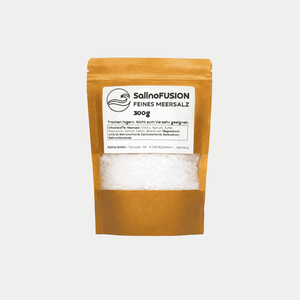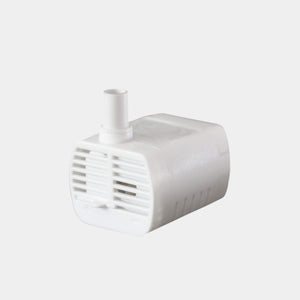Reading time: 10 minutes
Spring is finally here! The days are getting longer, temperatures are rising, and nature is awakening everywhere. But while many people have been eagerly awaiting the first rays of sunshine and colorful blossoms, for millions of others a challenging time is beginning. Sneezing, watery eyes, shortness of breath, and coughing – pollen can turn the most wonderful time of the year into a nightmare.
"It's finally spring, and I can't even enjoy a walk" – we hear this phrase again and again from those affected. But it doesn't have to be that way! With the right protective measures, even allergy sufferers and people with sensitive airways can enjoy spring to the fullest. In this article, we present eight particularly effective methods to protect your airways and breathe freely despite pollen.
Why spring puts so much strain on our respiratory system

With the first warm days, pollen season begins. Hazel, alder, birch, and later also grasses – each plant species has its peak flowering period, which can cause exposure to pollen for months. The microscopic pollen is carried long distances by the wind and can penetrate deep into our respiratory tract.
For allergy sufferers, this means their immune system sounds the alarm and launches a defensive reaction – with all the unpleasant side effects such as inflammation of the nasal mucosa, increased mucus production, and constricted airways. People with asthma, COPD, or chronic bronchitis also suffer from the additional strain on their already sensitive airways.
The good news: There are effective strategies to protect your respiratory system and significantly alleviate symptoms. With the following 8 methods, you can get back to an active lifestyle – despite the pollen count and spring air.
Method 1: Pollen avoidance through intelligent daily planning

The most effective protection remains avoiding contact with allergens. Adjusting your daily schedule can significantly reduce pollen exposure.
What really helps:
· Pay attention to pollen seasons : The highest pollen concentrations for birch and grasses occur between 5 and 9 a.m. and between 5 and 7 p.m. If possible, plan outdoor activities outside of these times.
· Weather-dependent planning : After periods of rain, pollen concentrations are significantly reduced for 1-3 hours. Pollen levels can drop by up to 80% after a 30-minute rain shower.
· Take advantage of geographical differences : Pollen concentrations are lower near water, in forests (except birch forests during the birch pollen season), and at higher elevations. Pollen levels at altitudes above 1,500 meters are up to 90% lower than in valleys.
Practical implementation for your everyday life:
1. Use special pollen apps for daily pollen counts
2. Move sporting activities to the late morning or early afternoon
3. Go for a walk after rain showers, not in sunshine and wind
4. Plan holidays in low-pollen regions (e.g. high mountains or sea coasts)
Method 2: The right protective barriers for your home

Your home should be a safe haven for your respiratory system. Pollen concentrations in unprotected indoor spaces can reach up to 70% of outdoor concentrations.
Proven protective measures:
· Pollen screens : Special pollen screens for windows can reduce indoor pollen levels by up to 90%. These fine screens trap pollen while allowing air and light to pass through.
· Optimal ventilation times : In the city, ventilate between 6 and 8 a.m., and in the countryside after 8 p.m. These are the times when pollen concentrations in the area are lowest.
· Air purifiers with HEPA filters : High-quality air purifiers with HEPA 14 filters can remove 99.995% of all airborne particles, including pollen, from the room air.
Checklist for your home:
· Install pollen screens on all regularly opened windows
· Daily damp wiping of smooth surfaces (reduces pollen)
· Take off street clothes in the hallway and do not take them into the bedroom
· Do not dry laundry outdoors during heavy pollen season
· Wash your hair before going to bed to remove pollen
Method 3: Natural respiratory cleansing
Our respiratory tract has natural cleansing mechanisms that we can support. Regular nasal douches and inhalations are proven methods for cleansing and moisturizing the mucous membranes.
Effective cleaning methods:
· Nasal irrigation with saline water : Regular nasal irrigation with isotonic saline solution can significantly reduce the symptoms of allergic rhinitis. The irrigation mechanically removes pollen and moistens the mucous membranes.
· Steam inhalations : Regular steam inhalations can significantly relieve the symptoms of respiratory irritation. Inhalations with Emser salt or essential oils such as eucalyptus are particularly effective.
· Humidification of the room air : A relative humidity between 40% and 60% optimally supports the mucous membrane function and at the same time minimizes the risk of mold formation.
Practical instructions for nasal rinsing:
1. Mix 1/4 teaspoon of salt (not iodized) with 250ml of body-warm, boiled water
2. Fill a nasal douche with the solution
3. Bent over the sink, insert the nasal douche into one nostril
4. Tilt your head to the side so that the solution can flow out of the other nostril
5. Repeat the process on the other side
6. Optimal: 1-2 times daily during pollen season
Method 4: The healing power of salty air

The therapeutic effects of salty air on the respiratory system have been known for centuries. From coastal treatments (thalassotherapy) to modern saline inhalation devices, the positive effect on the respiratory system is undisputed.
Known effects:
· Expectorant effect : Salty air liquefies the mucus in the respiratory tract through its hygroscopic effect, making it easier to cough up.
· Anti-inflammatory properties : Salt particles in the air can reduce the concentration of pro-inflammatory substances in the respiratory tract and thus reduce swelling.
· Improved respiratory tract cleansing : Regularly inhaling salty air supports the natural cleansing mechanisms of the respiratory tract and can reduce the frequency of infections.
How to integrate salty air into your everyday life:
· Use special mini-salt baths for home use, which allow continuous, passive application
· Visit graduation towers or salt chambers in your area (1-2 hours per week has a proven positive effect)
· If possible, plan a short holiday on the North Sea or Baltic Sea during the peak of the pollen season
Method 5: Strategies for on the go

You can also effectively protect your respiratory system while on the go. A combination of different measures can significantly reduce pollen exposure.
Proven protective measures:
· Special pollen protection masks : High-quality masks that meet the FFP2 standard can significantly reduce the intake of pollen through the respiratory tract. Special pollen masks with an additional layer of activated carbon are particularly effective.
· Safety glasses : Wearing sunglasses with side shields can significantly reduce the amount of pollen entering the eyes. This also indirectly prevents the "eye-nose reflex system," in which eye irritation leads to increased nasal symptoms.
· Pollen filters in cars : High-quality pollen filters for vehicle air conditioning systems (activated carbon filters with HEPA certification) can filter up to 99% of pollen from the incoming air. Regular replacement is important, ideally at the beginning of the pollen season.
Practical checklist for on the go:
· Avoid cycling during peak pollen season
· Wear special protective masks and goggles during heavy pollen counts
· Keep car windows closed and activate the air recirculation function
· Wipe your face and rinse your nose after prolonged outdoor exposure
· Wash your hands frequently to remove pollen that could otherwise get on your face
Method 6: Immune system boost for respiratory tract

A strong immune system can significantly influence the response to allergens and respiratory irritations. There are concrete connections between nutrition, micronutrients, and respiratory health.
Key findings:
· Vitamin D and respiratory health : Adequate vitamin D levels can reduce the frequency of respiratory infections. Furthermore, a reduction in allergic symptoms has been observed with optimal vitamin D levels.
· Omega-3 fatty acids : A sufficient supply of omega-3 fatty acids promotes the production of anti-inflammatory mediators and thus weakens allergic reactions.
· Prebiotics and probiotics : Specific probiotic bacterial strains (especially Lactobacillus rhamnosus GG and Bifidobacterium lactis BB-12) can improve immune tolerance and reduce allergic reactions.
Practical nutritional recommendations:
· Regularly eat fatty sea fish (salmon, mackerel, herring) for omega-3 fatty acids
· Incorporate fermented foods such as yogurt, kefir and sauerkraut into your diet
· Make sure you eat a varied, colorful diet rich in antioxidants (berries, citrus fruits, broccoli)
· Have your vitamin D levels checked and supplement if necessary after consulting a doctor
· Reduce highly processed foods and sugar, which can promote inflammatory processes
Method 7: Herbal support for respiratory problems

Phytotherapy offers natural support for the respiratory system. Certain plants and their constituents can reduce inflammation, loosen mucus, and soothe the airways.
Proven herbal helpers:
· Thyme herb : The expectorant and antimicrobial effects of the thymol and carvacrol compounds in thyme herb are well documented. When taken as a tea or extract, it can significantly improve the symptoms of respiratory irritation.
· Ribwort plantain : The immunomodulating and anti-irritant effects of the iridoid glycosides and mucilage in ribwort plantain are well known. Regular use as a tea or juice can significantly reduce cough frequency.
· Eucalyptus : Inhaling eucalyptus oil can measurably improve lung function and reduce the symptoms of respiratory irritation.
Application tips:
· Thyme honey: Dissolve 1 teaspoon in warm water or tea, take 3 times daily
· Plantain tea: Pour 2 teaspoons of dried herb into 250ml of boiling water, let it steep for 10 minutes, and drink 2-3 cups daily.
· Eucalyptus inhalation: Add 3-4 drops of eucalyptus oil to a bowl of hot water, cover your head with a towel, and inhale for 5-10 minutes
Method 8: The correct breathing technique

The way we breathe significantly influences our respiratory health. Special breathing techniques can improve breathing efficiency and relieve symptoms.
Proven techniques:
· Nasal breathing vs. mouth breathing : Consistently breathing through the nose significantly reduces pollen intake. The nose filters, warms, and humidifies the air, thus reducing strain on the lower respiratory tract.
· Respiratory muscle training : Regular training of the respiratory muscles can increase vital capacity and reduce attacks of respiratory distress.
· Yoga breathing techniques : Pranayama breathing exercises from yoga activate the parasympathetic nervous system, reduce inflammatory markers and, when used regularly, lead to a measurable improvement in lung function.
Practical breathing exercises for everyday life:
1. Pursed lip breathing : Inhale through the nose, exhale through slightly closed lips (like blowing out a candle) – slows down exhalation and improves gas exchange
2. Diaphragmatic breathing : Place your hand on your stomach, breathe in deeply and make sure that your hand moves outwards (stomach bulges), while breathing out, lower your hand again
3. Alternate breathing : Inhale alternately through one nostril and exhale through the other (right thumb closes right nostril, left ring finger closes left nostril)
Your personal spring respiratory protection
After the 8 methods presented, you may be wondering, "So how do I actually implement this?" Here's a simple 3-step plan you can start with right away:
Step 1: Immediate measures (can be implemented within 24 hours)
· Download a pollen count app and check the current pollen count (such as "Pollen Forecast" from Hexal or "Husteblume" for regional pollen counts)
· Keep windows closed during peak pollen season
· Wash your hair in the evening to remove pollen
· Start with simple nasal rinses with saline water
Step 2: Short-term improvements (within one week)
· Install pollen screens on the main windows
· Get sunglasses with side shields for outdoors
· Start with one of the breathing exercises presented
· Incorporate more anti-inflammatory foods into your diet
Step 3: Long-term strategies
· Create a salt air environment in your home
· Plan your outdoor activities according to pollen season
· Continuously strengthen your immune system
· Talk to your doctor about possible hyposensitization
Combining these methods creates an effective protective shield for your respiratory system. And the best part: You don't have to implement everything at once. Start with the measures that are easiest for you and gradually expand your repertoire.
Conclusion: Free breathing despite pollen is possible

The good news: You don't have to suffer from pollen! With the eight methods presented here, you have effective tools at your disposal to protect your respiratory system and enjoy spring. Combining different approaches, in particular, often yields amazing results.
Remember: everyone is different, and not every method works equally well for everyone. Experiment and find out what works best for you.
A particularly promising approach that is gaining increasing attention is the use of salty air to support the respiratory system. What was once only possible by traveling to the sea or visiting salt mines can now be easily achieved in your own home. SalinoVatis offers an innovative solution for this with its mini-salt system. This compact device brings the healing effects of salt air directly into your home and can help soothe and strengthen your respiratory system. Thanks to a special 3D-printed construction, it produces a higher salt concentration than conventional devices and operates completely silently – a pleasant companion, especially at night.
Don't give spring and pollen a chance to spoil the most wonderful time of the year. With the right protective measures, you can breathe a sigh of relief and enjoy spring to the fullest.



